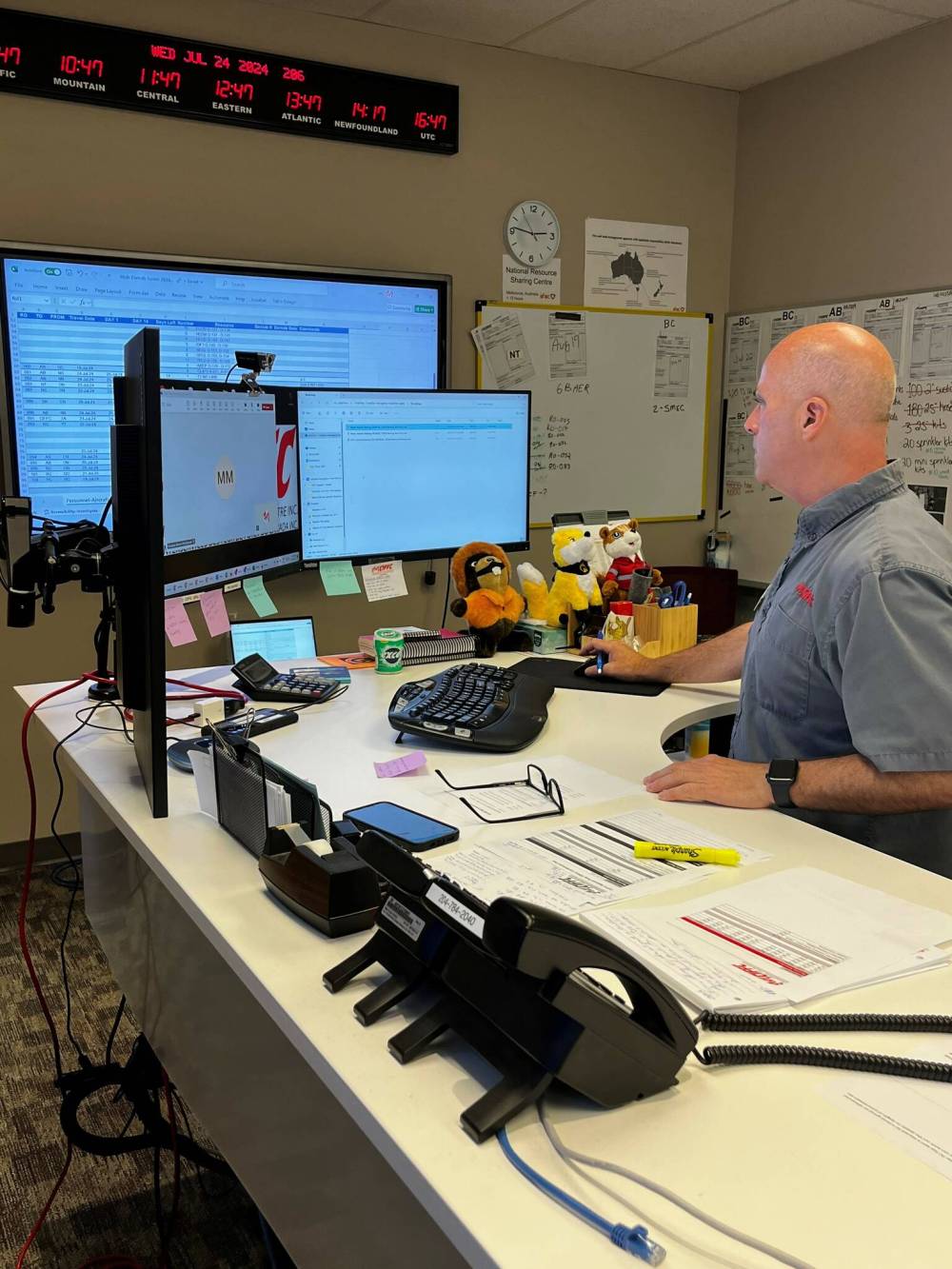As wildfires rage across swaths of Alberta and British Columbia, a massive co-ordination of equipment and personnel destined for the front lines is being orchestrated from a small room in Winnipeg.
Below the red lights of illuminated time zones is a big-screen TV displaying destinations for firefighting resources — everything from water bombers to hose lines — from across Canada.
Canadian Interagency Forest Fire Centre duty officers Stephen Tulle or Marc Mousseau staff the desk on any given day, surrounded by three computer monitors, stacks of paper and a constantly ringing phone.

SUPPLIED
Canadian Interagency Forest Fire Centre duty officer Stephen Tulle helps co-ordinate resources and firefighters where they’re needed.
Started in 1982, following resource-strapped fire seasons from 1979-81, the national non-profit is owned and operated by the federal, provincial, and territorial governments, and is tasked with co-ordinating wildfire resource sharing across the country.
The Canadian Interagency Forest Fire Centre duty officer is the first point of contact for a province in need. Six support staff work in the background.
The centre also orchestrates getting boots on the ground from other countries when resources are tapped.
Canadian Interagency Forest Fire Centre spokesperson Alexandria Jones said the country is sitting at a national preparedness level of five, reached July 15. Five is the highest level possible.
“That means we’ve exhausted our national resources; they’re all currently engaged,” Jones said by phone Wednesday.
Last year, the centre announced a level five on May 11. It was finally revoked on Sept. 7.
Wildfire firefighters from Australia, New Zealand and South Africa are currently arriving in Canada to combat fires in B.C. and Alberta, which have so far consumed 818,510 hectares and 550,176 hectares, respectively.
B.C. was contending with 423 active fires Thursday, while Alberta had 174 on their hands, including a massive blaze that destroyed parts of Jasper Wednesday.
Plans are also being worked out to bring in firefighters from Costa Rica and Mexico.
Information about what’s needed where and when rolls into the Winnipeg office throughout the day.
“These things can constantly change,” Jones said.
“If Alberta and B.C. gets a dumping of rain this weekend, and resource needs decrease rapidly, that affects our preparedness level,” she said.
This year, Jones said, national resources were enough “for quite some time.”
But fires in Saskatchewan and the Northwest Territories earlier this month pushed domestic resources over the brink, requiring Canada to call on the international community.
Although provinces like Ontario and Nova Scotia are dispatching people and equipment out west, Manitoba is busy fighting its own battles with 58 active fires in the province’s north as of Wednesday.
Provincial firefighting resources to stay local
Premier Wab Kinew told reporters Thursday the province is contending with northern fires, particularly around Lynn Lake and Marcel Colomb First Nation, 800 kilometres northwest of Winnipeg, where residents were evacuated.
“Given the current wildfire situation in northern Manitoba, no provincial firefighting resources are being sent to other jurisdictions,” a provincial spokesperson told the Free Press.
According to forest fire centre data, 66,374 hectares have burned so far this year in Manitoba. In 2023, fires destroyed 82,000 hectares.
The province has 58 full-time provincial wildfire firefighters, assisted by 339 seasonal firefighters, at its disposal.
There are 40 crews who can be dropped in with little notice to attack an uncontrolled fire.
The province also operates seven water bombers and nine contracted helicopters, a spokesperson said.
According to the forest fire centre, Manitoba has received 68 firefighters and staff from other provinces, 200 lengths of hose and 200 sprinklers so far this year.
Meanwhile, the phones in Winnipeg will continue to ring in the weeks ahead.
“We’re just here to make their lives a little bit easier, and get (firefighters) the resources they need,” Jones said.
In addition to co-ordinating people and equipment, the Canadian Interagency Forest Fire Centre collects letters of support to send to crews working long hours on the front lines, with the aim of boosting morale.
Letters can be addressed to: 1749 Ellice Avenue, Winnipeg, MB, R3H 1A6.
jordan.snobelen@freepress.mb.ca
Jordan Snobelen
Reporter
Jordan Snobelen is a general assignment reporter for the Free Press. He spent four years reporting for community newspapers in Ontario before joining the Free Press’s city desk in 2024. Read more about Jordan.
Every piece of reporting Jordan produces is reviewed by an editing team before it is posted online or published in print — part of the Free Press‘s tradition, since 1872, of producing reliable independent journalism. Read more about Free Press’s history and mandate, and learn how our newsroom operates.
Our newsroom depends on a growing audience of readers to power our journalism. If you are not a paid reader, please consider becoming a subscriber.
Our newsroom depends on its audience of readers to power our journalism. Thank you for your support.